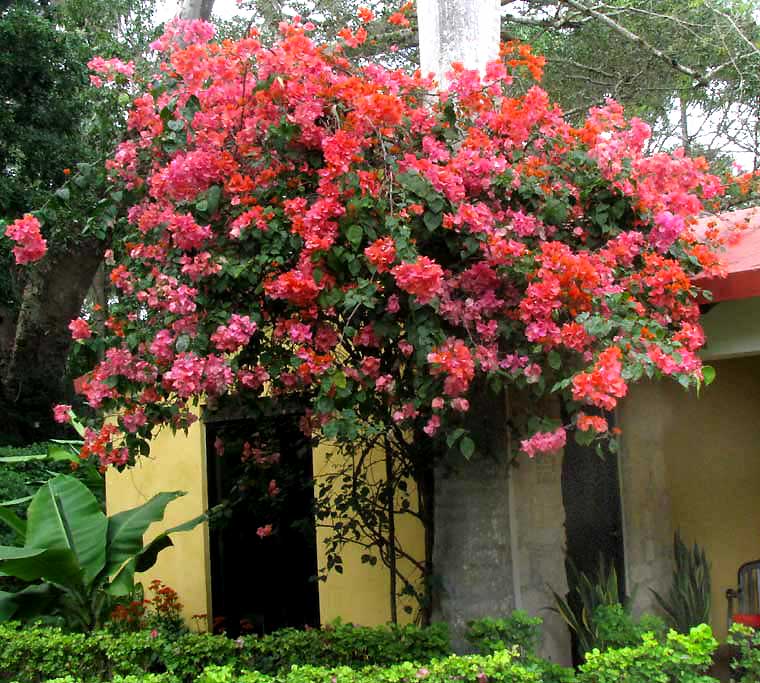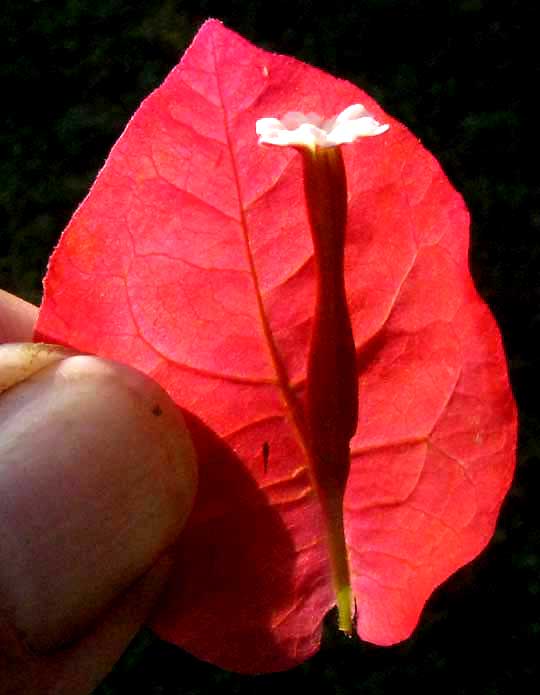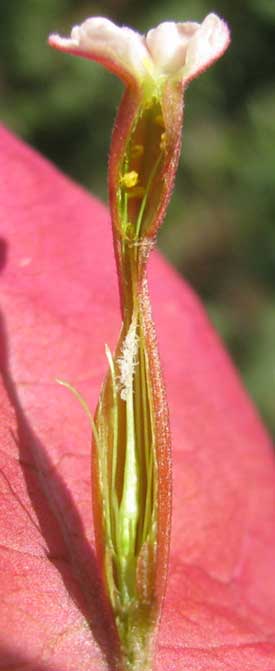Excerpts from Jim Conrad's
Naturalist Newsletter

from the January 8, 2012 Newsletter issued from Hacienda Chichen Resort beside Chichén Itzá Ruins; limestone bedrock; elevation ~39m (~128ft), N20.675°, W88.569°; central Yucatán state, MÉXICO
BOUGAINVILLEA FLOWERS
Bougainvilleas are among the most planted, most appreciated and most beautiful of all tropical plants. They're native to South America but are planted in the tropics worldwide. Down here if you see a woody vine overflowing its arbor or fence, scrambling onto rooftops and even flowing into neighboring trees, and bearing unnaturally large clusters of usually-red flowers that seem to last and last, probably that's a Bougainvillea. You can see a typical planting here at the Hacienda above.
Up close, the gaudy clusters resolve into curiously three-sided, 1½-inch tall (4cm) structures, as shown below:

Most folks call that structure "the flower," but it isn't. It's a cluster of three flowers. An actual flower with its subtending bract is shown below:

Bracts are modified leaves and in this picture you can see veins suggestive of the ancestral leaves from which the bracts were modified. Many bracts are so highly modified that the veins don't look like veins, or are nonexistent. Once a wild Bougainvillea's flower dries up and shrivels, a dry fruit appears affixed to the papery bract. The bract catches in the wind and helps the fruit disseminate away from the parent plant.
 In the above picture, the dark, slender thing arising from the bract's base is the flower's slender calyx, which is red without and white inside. Bougainvillea flowers bear no corollas, but you can see that the calyx does a good job mimicking one. Notice that the calyx bears five lobes like a normal corolla. A longitudinal section showing the flower's sexual parts inside the cylindrical calyx tube can be seen at the right.
In the above picture, the dark, slender thing arising from the bract's base is the flower's slender calyx, which is red without and white inside. Bougainvillea flowers bear no corollas, but you can see that the calyx does a good job mimicking one. Notice that the calyx bears five lobes like a normal corolla. A longitudinal section showing the flower's sexual parts inside the cylindrical calyx tube can be seen at the right.
There the stamens' sandgrain-like, yellow anthers reside atop long, pale, hairlike filaments of unequal lengths joining at their bases. These and other flower features confirm the Bouganvilleas's membership in the Four-O'Clock Family, the Nyctaginaceae, which is a family mainly of the tropics and subtropics, and predominantly in the Americas.
Bouganvillea taxonomy is a mess, the experts defining as few as four species in the genus BOUGANVILLEA and as many as 18. There's been so much hybridizing between species, resulting in over 300 named cultivars, that assigning a species name to a particular plant is hard to impossible, and probably misleading. In traditional, outdated taxonomy, however, the species shown here would be Bouganvillea glabra.
Bouganvilleas are named after French Navy admiral and explorer Louis Antoine de Bougainville.